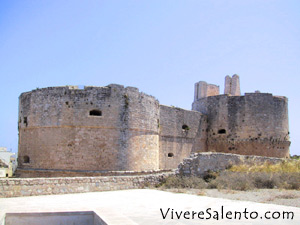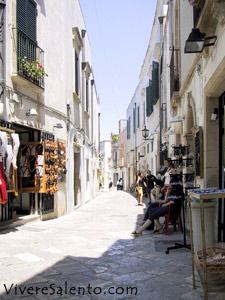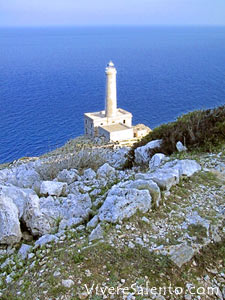|
|

| Inhabitants's
name: Otrantini |
On the coat
of arms of Otranto there is a black snake twisted around a tower inhaling the
oil from an oil lamp,
 and
at the bottom there is a writing "CIVITAS FIDELISSIMA HIDRUNTI" meaning
"Faithful Town of Otranto," with evident reference to the heroic resistance of
the inhabitants to the Turkish invasion. Among the possible founders of Otranto
there are some important names like: Minos, Dedalus, Hercules, Japigio and
Lizio, and even if the origins of this small town are not very well known some
researchers think that the name of Otranto comes from that of a small river
(Idro) that crosses the town. The abundant archaeological finds and the presence
of the important Romanelli Cave prove that Otranto was already an important
centre during the Paleolithic Age. Near Otranto you can visit the small inlet of
Porto Badisco that according to the story of Virgil was the place where Aeneas
disembarked. In 1970 this place became famous for the discovery of the Cave of
the Bucks, one of and
at the bottom there is a writing "CIVITAS FIDELISSIMA HIDRUNTI" meaning
"Faithful Town of Otranto," with evident reference to the heroic resistance of
the inhabitants to the Turkish invasion. Among the possible founders of Otranto
there are some important names like: Minos, Dedalus, Hercules, Japigio and
Lizio, and even if the origins of this small town are not very well known some
researchers think that the name of Otranto comes from that of a small river
(Idro) that crosses the town. The abundant archaeological finds and the presence
of the important Romanelli Cave prove that Otranto was already an important
centre during the Paleolithic Age. Near Otranto you can visit the small inlet of
Porto Badisco that according to the story of Virgil was the place where Aeneas
disembarked. In 1970 this place became famous for the discovery of the Cave of
the Bucks, one of most important prehistoric sites in Europe. On the inside walls there are some
representations of hunting, of animals, anthropomorphous figures and of some
abstract sketches Most researchers think that this symbolism is closely
connected to the magic and religious practices of that epoch. In the following
centuries Otranto was incorporated into the Magna Greece, and later it was
conquered by the Romans. It became a rich Roman Town Hall and produced silver
and bronze coins. After the fall of the Roman Empire Otranto was governed by
Constantinople and then, by f the Normans, the Swabians, the Angevins and the
Aragoneses. In 1480 Mohammed II disembarked at Otranto with 18,000 soldiers: his
aim was to conquer Italy and, together with the Spanish Arabic to fight against
the Christian Europe. After sixteen days of besiege the town was razed to the
ground. On August 14th 800 Martyrs were beheaded since they had refused to deny
their Christian religion in favor of the Moslem one. After around a year the
Turks were finally defeated. Among the most famous native characters there are
Francesco Antonio Primaldo Catara, rector of the Episcopalian Seminary and the
first supporter of the canonization of
most important prehistoric sites in Europe. On the inside walls there are some
representations of hunting, of animals, anthropomorphous figures and of some
abstract sketches Most researchers think that this symbolism is closely
connected to the magic and religious practices of that epoch. In the following
centuries Otranto was incorporated into the Magna Greece, and later it was
conquered by the Romans. It became a rich Roman Town Hall and produced silver
and bronze coins. After the fall of the Roman Empire Otranto was governed by
Constantinople and then, by f the Normans, the Swabians, the Angevins and the
Aragoneses. In 1480 Mohammed II disembarked at Otranto with 18,000 soldiers: his
aim was to conquer Italy and, together with the Spanish Arabic to fight against
the Christian Europe. After sixteen days of besiege the town was razed to the
ground. On August 14th 800 Martyrs were beheaded since they had refused to deny
their Christian religion in favor of the Moslem one. After around a year the
Turks were finally defeated. Among the most famous native characters there are
Francesco Antonio Primaldo Catara, rector of the Episcopalian Seminary and the
first supporter of the canonization of
 the
Martyrs of Otranto ( 1772). Niceta of Otranto was a theologian, a poet, a
philosopher and a brilliant speaker: he run the Abbey of St. Nicola of Casole
that became the most important cultural centre of that epoch (about 1200 ).
Lorenzo Scrupoli devoted himself to the study of the religion, depriving himself
of everything. He wrote a lot of works as "del modo di consolare ed aiutare gli
infermi a ben morire" and "Il combattimento spirituale," that was translated
into different languages. Giulio Capone, well-known lawyer of the Kingdom of
Naples, taught at the University. Pantaleone made an exceptional mosaic called "
Tree of Life" that can be seen in the Cathedral of Otranto. the
Martyrs of Otranto ( 1772). Niceta of Otranto was a theologian, a poet, a
philosopher and a brilliant speaker: he run the Abbey of St. Nicola of Casole
that became the most important cultural centre of that epoch (about 1200 ).
Lorenzo Scrupoli devoted himself to the study of the religion, depriving himself
of everything. He wrote a lot of works as "del modo di consolare ed aiutare gli
infermi a ben morire" and "Il combattimento spirituale," that was translated
into different languages. Giulio Capone, well-known lawyer of the Kingdom of
Naples, taught at the University. Pantaleone made an exceptional mosaic called "
Tree of Life" that can be seen in the Cathedral of Otranto.
|